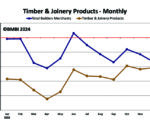Higher-end products drive market growth
In his latest market report, Palmer paints a complex picture mixed with predictions of growth coupled with market contraction warnings
 Palmer Market Research’s new report into the performance and prospects of the UK window and door industry, paints a complex picture of growth but also market contraction, as the UK continues its journey towards Brexit. Published this month, Palmer’s new market research report, The Window, Door and Conservatory Markets in Housing in Great Britain, argues that a flattening of the market in 2015 saw total volume fall by 0.7%. This was, however, offset by a shift towards higher-end products and higher-value installations, which delivered a 2% increase in installed value to £4.20 billion.
Palmer Market Research’s new report into the performance and prospects of the UK window and door industry, paints a complex picture of growth but also market contraction, as the UK continues its journey towards Brexit. Published this month, Palmer’s new market research report, The Window, Door and Conservatory Markets in Housing in Great Britain, argues that a flattening of the market in 2015 saw total volume fall by 0.7%. This was, however, offset by a shift towards higher-end products and higher-value installations, which delivered a 2% increase in installed value to £4.20 billion.
Palmer suggests that going forward, prospects are highly variable depending on sector and product offering. As in previous years, the home improvement sector continues to dominate, with a value of £3,242 million last year. Going forward into this year, Palmer suggests an above forecast performance, with growth at 1.5% to £3.28 billion by the end of 2016. But this is tempered by a significant revision of forecasts for the new-build sector. Tipped for growth of 32 per cent over a five-year forecast period through to 2020 in last year’s report – Palmer now suggests that it will contract, by three per cent over the same period.
Robert Palmer, Managing Director, Palmer Market Research, said: “After an initial tumble following the Brexit vote, consumer confidence has steadied somewhat. We would suggest, however, that the uncertainty that will be generated as the UK negotiates its exit from the EU, is likely to dampen demand in home improvements, with a fall in value in 2017 and 2018 before a flattening through to 2020. This is also likely to lead to a ‘cooling-off’ of the housing market and a possible dip in prices, something which traditionally slows the supply of new homes. This may become more acute if first-time buyers opt to wait-out Brexit before getting on the property ladder.”
Although, according to Palmer, for the most part unaffected by Brexit with capital spending already allocated, forecasts for the social sector, remain flat through to 2020. But as in previous years, Palmer suggests that there will be winners and losers based on not only market but product and material type. Aluminium remains tipped for growth, notably in the bi-folding door sector with pockets of significant opportunity throughout markets. Palmer also suggests that there has been a shift in the window sector towards premium products and away from ‘standard’ PVC-U installations. Forecasts for the entrance door market remain for growth, while Palmer suggests that last year also saw a resurgence in patio doors – up by 6%.
Palmer argues the conservatory sector continued its somewhat lacklustre performance last year, with a downward trend predicted through to 2020. This is, however, offset by the shift towards ‘family room’ type installations and growth in the replacements market. “What we’re seeing is a set of very different fortunes for different products in different markets. Certainly, aluminium as a material type and bi-fold doors remain in the ascendancy, building share in new markets,” continues Palmer. He concludes: “Although Brexit creates a level of uncertainty – and quite what impact this is going to have on consumer confidence is, as we have seen in the months since June, difficult to predict – there remain some very sizeable pockets of opportunity but these are highly variable defined by not only product type but material type.”
Tel: 020 83908131
E: info@palmermarketresearch.co.uk











